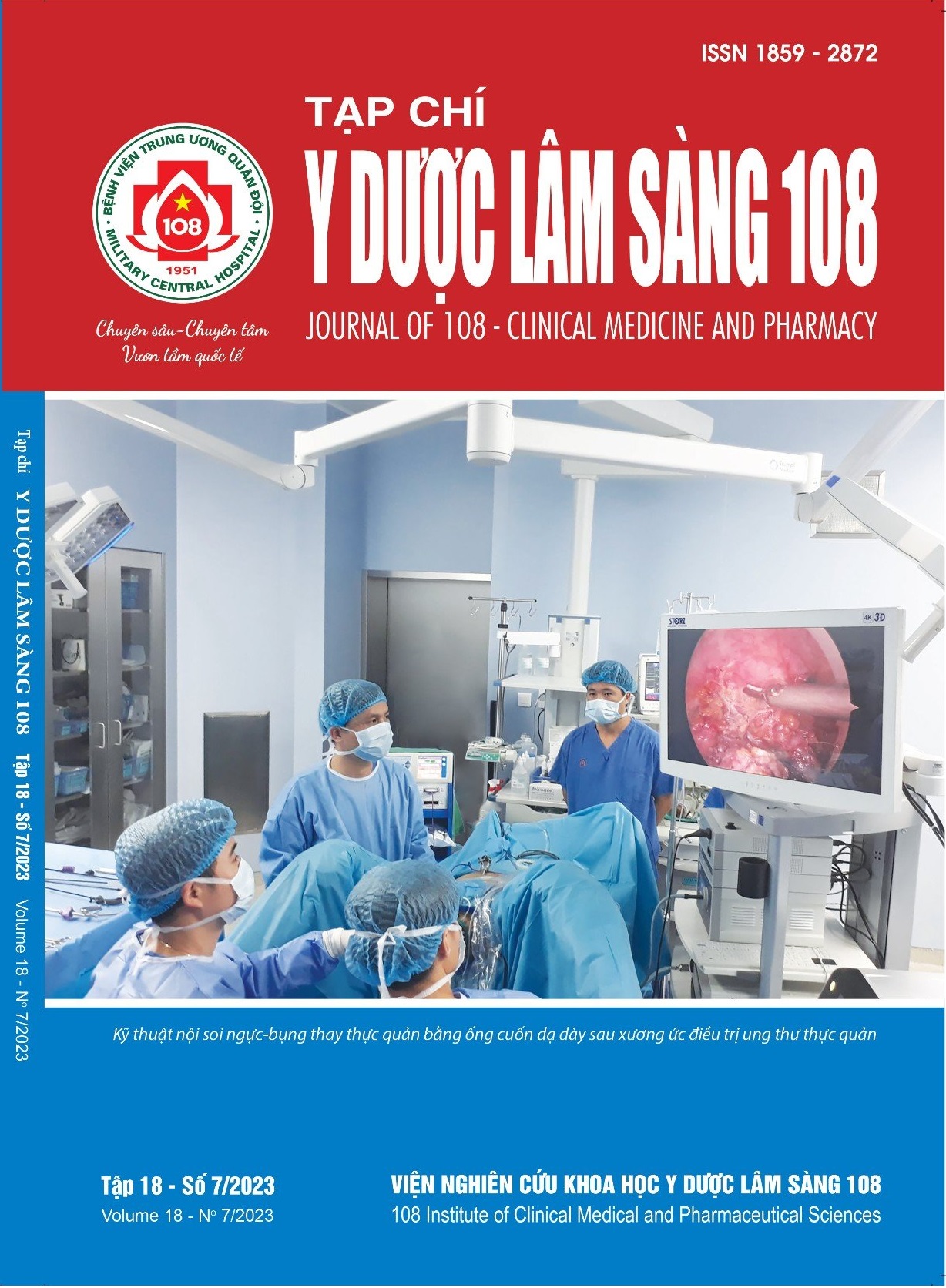Technical characteristics of video-assisted transthoracic esophagectomy with substernal gastric tube for the treatment of esophageal cancer
Main Article Content
Keywords
Abstract
Objective: To study the technical characteristics, feasibility, and safety of video-assisted transthoracic esophagectomy with the substernal gastric tube in the treatment of esophageal cancer at 108 Military Central Hospital. Subject and method: A retrospective and prospective study, including 77 patients in middle and lower thirds who underwent video-assisted transthoracic esophagectomy with the substernal gastric tube from November 2018 to November 2022. The technical parameters of surgery were recorded and analyzed using SPSS 17.0 software. Result: Mean age was 57.49 ± 7.89 years. 100% of patients were male. 57.15% used a single endotracheal tube. The group using the single endotracheal tube had a significantly higher number of lymph nodes removed and the number of lymph nodes along the left recurrent laryngeal nerve than that using a double endotracheal tube. 64.9% of patients used a large gastric tube. The majority of patients used 2 staplers and 3 staplers (89.6%). There were 10.4% of patients who received stitches to enhance the cutting area. There were no cases of bleeding at stapler line and gastric tube leakage. The majority of patients who made anastomosis using a circular stapler (70.1%). The cases of placing anastomosis above the sternal notch accounted for a high rate (76.6%). The majority of patients (87%) had laparoscopic substernal tunneling. 7.8% of patients identified the wrong place to enter the tunnel entrance. The wrong direction of the tunnel was 13%. 12.98% of patients had complications when creating the tunnel, of which: 5.2% were pleural tears, 2.6% were pericardial tears, 3.9% were minor bleeding, and 1.3% were tunnel was not wide enough. Conclusion: The video-assisted transthoracic esophagectomy with substernal gastric tube is feasible, safe, and has a low rate of complications when creating the tunnel.
Article Details
References
2. Lagergren J, Bottai M, and Santoni G (2021) Patient age and survival after surgery for esophageal cancer. Ann Surg Oncol 28(1): 159-166.
3. Watanabe M, Toh Y, Ishihara R et al (2023) Comprehensive registry of esophageal cancer in Japan, 2015. Esophagus Off J Jpn Esophageal Soc 20(1): 1-28.
4. van Lanschot JJ, van Blankenstein M, Oei HY et al (1999) Randomized comparison of prevertebral and retrosternal gastric tube reconstruction after resection of oesophageal carcinoma. Br J Surg 86(1): 102-108.
5. Shu YS, Sun C, Shi WP et al (2013) Tubular stomach or whole stomach for esophagectomy through cervico-thoraco-abdominal approach: A comparative clinical study on anastomotic leakage. Ir J Med Sci 182: 25-43.
6. Nishikawa K, Fujita T, Hasegawa Y et al (2018) Association of level of anastomosis and anastomotic leak after esophagectomy in anterior mediastinal reconstruction. Esophagus Off J Jpn Esophageal Soc 15(4): 231-238.
7. Javed A and Agarwal AK (2013) Total laparoscopic esophageal bypass using a colonic conduit for orrosiveinduced esophageal stricture. Surg Endosc 27(10): 3726-3732.
8. Zhang R, Liu S, Sun H et al (2014) The application of single-lumen endotracheal tube anaesthesia with artificial pneumothorax in thoracolaparoscopic oesophagectomy. Interact Cardiovasc Thorac Surg 19(2): 308-310.
9. Chuang KH, Lai HH, Chen Y et al (2021) Improvement of surgical complications using single-lumen endotracheal tube intubation and artificial carbon dioxide pneumothorax in esophagectomy: A meta-analysis. J Cardiothorac Surg 16(1): 100-107.
10. Zhang W, Yu D, Peng J et al (2017) Gastric-tube versus whole-stomach esophagectomy for esophageal cancer: A systematic review and meta-analysis. PloS One 12(3): 370-389.
11. Ercan S, Rice TW, Murthy SC et al (2005) Does esophagogastric anastomotic technique influence the outcome of patients with esophageal cancer?. J Thorac Cardiovasc Surg 129(3): 623-631.
12. Kurahashi Y, Ishida Y, Kumamoto T et al (2021) Anastomosis behind the sternoclavicular joint is associated with increased incidence of anastomotic stenosis in retrosternal reconstruction with a gastric conduit after esophagectomy. Dis Esophagus 34(4): 89-97.
13. Hu H, Ye T, Zhang Y et al (2012) Modifications in retrosternal reconstruction after oesophagogastrectomy may reduce the incidence of anastomotic leakage. Eur J Cardio-Thorac Surg Off J Eur Assoc Cardio-Thorac Surg 42(2): 359–363.
 ISSN: 1859 - 2872
ISSN: 1859 - 2872
